Species
{{start}}
{{end}}
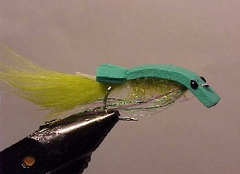
{{+1}}Wiggle minnow{{-1}}
{{start}}
By varying the materials used, the colours and size I have accounted for trout, bream, flathead, mangrove jack and even barramundi on wiggle minnows. The recipe I have set out below is just one version of this very adaptable fly and I would encourage you to individualize the fly to your own requirements.{{end}}
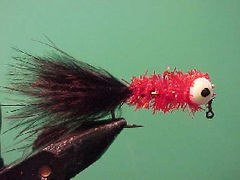
{{+1}}Booby{{-1}}
{{start}}
One of the best search flies in slow moving or still deeper water using a sinking line. If fishing from a fixed position cast it out, let the line sink to the desired depth, and then retrieve the line using a constant stripping motion, a pumping retrieve or a combination of both. The stripping speed should be varied.{{end}}
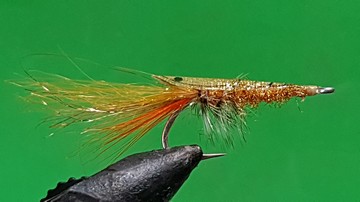
{{+1}}PET shell prawn{{-1}}
{{start}}
Prawns and shrimp are crustaceans, of the family Isopod, and are endemic to our Australian estuary waters. They are toward the top of the food chain for a lot of coastal species of fish including bream, flathead and whiting.{{end}}
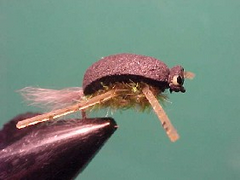
{{+1}}Foam beetle{{-1}}
{{start}}
Both floating and wet beetles (including drowned terrestrials beetles and aquatic beetles) should be fished in the current with as little line drag as possible or with a very short twitching action. A nondescript well tied beetle pattern if presented in the right way when fish have beetles on their menu, more often than not, will be accepted by fish. Consequently no fly box would be complete without a selection of beetle patterns.{{end}}
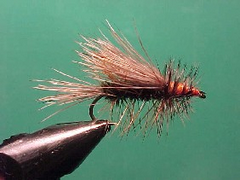
{{+1}}Stimulator variant{{-1}}
{{start}}
Whilst not tied to imitate any particular insect this down wing style of fly can be tied with your favorite materials and in your favorite colours to imitate a range of insects. It is a good prospecting fly when nothing appears to be happening. In larger sizes it can be twitched or fished dead drift to imitate a hopper, cicada or other terrestrial insect that has found itself in the water or in smaller sizes can be danced across the surface to imitate a caddis fly.{{end}}

{{+1}}Choosing the right trout fly{{-1}}
{{start}}
If you approach your fly selection on the basis that trout eat anything, over time (probably your first outing) you will miss fish that a more discerning fly fisher would at least win a look from. For example, on Lake Eucumbene when we are having a good hopper season, if you tie a fly on that is a good representation of the local hopper you have almost as good a chance as any hopper of attracting the interest of a fish. If however you tie the same fly on in the middle of August you can float that fly around the dam (in this case dam dam) all day and not even raise a fish.{{end}}
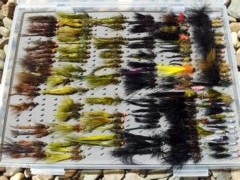
{{+1}}My “trout” fly boxes{{-1}}
{{start}}
The number of fly boxes you carry is obviously one of personal choice. One difficulty you may encounter when you are setting up your fly boxes is which flies you should include, and how many flies you should carry in your fly box or boxes. The last thing you want to be doing is standing on the bank of a river madly pulling flies out to find a fly you know is there . . .somewhere, but it isn't where you expected to find it or you fly box or boxes are so crowded with flies that the one you are desperately looking for is hidden away . . . somewhere.{{end}}
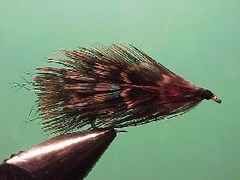
{{+1}}Mrs Simpson{{-1}}
{{start}}
We don't have Cockabullies here or an equivalent native fish but despite that they are one of our most successful flies around weed beds in both lakes and rivers. They can be fished from dead drift to “roly poly” but my favorite retrieve is a reasonable fast figure eight.{{end}}
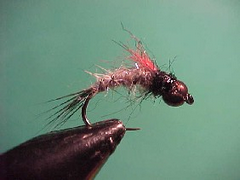
{{+1}}TBH caddis nymphs{{-1}}
{{start}}
This generic representation of a caddis nymph tied on a Czech nymph type hook is one of my favourites. A good buggy looking fly that also has a subtle hot spot emerging wing of UV material. It's such a good fly I carry it in a number of different colour options.{{end}}
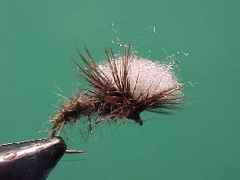
{{+1}}Klinkhammer{{-1}}
{{start}}
This Dutch fly designed for Grayling is one of the best emerger patterns and well suited when fishing to emerging mayflies and caddis. One of the big advantages of this pattern is that it is easily seen on the water because of the poly yarn post.{{end}}













